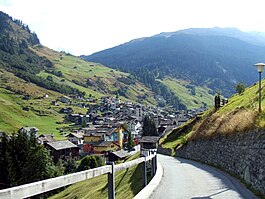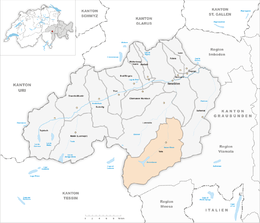Vals, Switzerland
| Vals | ||
|---|---|---|
 |
||
|
||
| Coordinates: 46°37′N 9°11′E / 46.617°N 9.183°ECoordinates: 46°37′N 9°11′E / 46.617°N 9.183°E | ||
| Country | Switzerland | |
| Canton | Graubünden | |
| District | Surselva | |
| Area | ||
| • Total | 175.56 km2 (67.78 sq mi) | |
| Elevation | 1,252 m (4,108 ft) | |
| Population (Dec 2015) | ||
| • Total | 990 | |
| • Density | 5.6/km2 (15/sq mi) | |
| Postal code | 7132 | |
| SFOS number | 3603 | |
| Surrounded by | Blenio (TI), Hinterrhein, Lumbrein, Nufenen, Safien, Vrin | |
| Website |
www SFSO statistics |
|
Vals (locally pronounced [ˈvals]) is a village and a municipality in the Surselva Region in the canton of Graubünden in Switzerland. On 1 January 2015 the former municipality of St. Martin merged into the municipality of Vals.
Archeological finds from the Bronze Age around the thermal baths and Tomül pass as well as Iron Age items on the slopes of the Valserberg indicate that this area was used before written history. In the 11th and 12th Centuries the Valser valley was extensively used by the local Romansh. Vals is first mentioned in mid 12th Century as in Valle. About 1290 they were 4 to 7 farm houses with flocks of sheep.
In the 13th Century, the Walser were driven from the canton of Wallis in south-west Switzerland into the Valser valley. The expansion of the Walliser German speaking Walser stopped in 1457 when they were forbidden from marrying or buying land from the Romansh speaking locals. They were able to settle at the end of the valley because that was the only place that wasn't claimed. The Walser also brought with them the Valliser style of house, which uses more wood than stone and has triangular roofs.
The village was settled around the 14th Century by Walser immigrants. Initially it was a held in fief for the Bishop of Chur by the von Tersnaus and von Mont families. In 1457 the German-speaking population was forbidden from purchasing land or marrying in the neighboring village of Tersnaus. The village church (consecrated 1345) was initially under the parish church of St. Vinzenz in Pleif (in Vella municipality), but in 1528 came under the authority of Tersnaus. After 1776, St. Martin's village church had a German-speaking Prebend though in 1868 it fell back under the authority of Tersnaus.
...
Wikipedia



